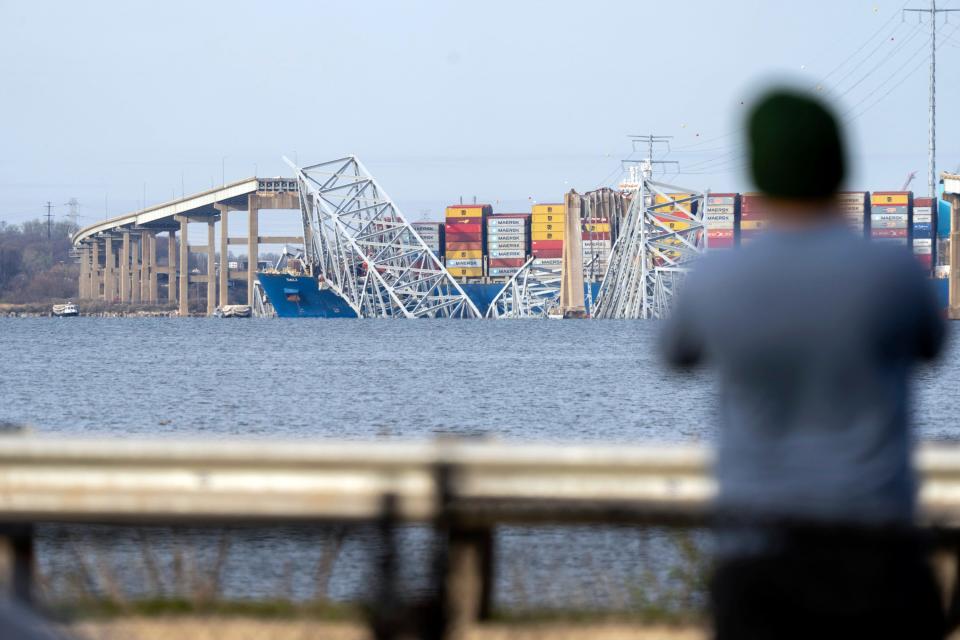Dali ship that wrecked Baltimore bridge was 'unseaworthy' before it left port, city claims
The owner and operators of the container ship that toppled the Francis Scott Key Bridge in Baltimore last month knowingly allowed an “unseaworthy” vessel to leave port and are directly responsible for the accident, the city of Baltimore said in a pair of court documents filed this week.
The documents were submitted in response to a petition by the Dali’s owner and its management company seeking to limit their financial liability for the March 26 accident; they claimed they were not at fault. But the city said the parties knew the Dali was unseaworthy because it had experienced a power supply problem hours before it left the Port of Baltimore early that morning.
Instead of fixing the problem, the city said, those responsible for the ship all but ignored it before leaving the port en route to Sri Lanka. Minutes later, the Dali lost power and struck the bridge, “causing the bridge’s immediate collapse, killing at least six individuals, destroying Baltimore property, and bringing the region’s primary economic engine to a grinding halt,” the city said in one of its filings.
“None of this should have happened,” the city added.
The city’s claim referenced an Associated Press report April 15 citing an unidentified source who said alarms had sounded on some of the ship’s refrigerated containers before it left port, indicating an inconsistent power supply.

Neither the ship’s owner, Grace Ocean Private Ltd., nor its manager, Synergy Marine Private Ltd., should be allowed to limit its liability in the case, the city said, because both had failed to properly train and supervise the crew, failed to follow safe work and operational procedures, and failed properly maintain, equip and inspect the vessel.
The crash was a direct result of the owner and operators’ “carelessness, negligence, gross negligence, and recklessness, and as a result of the unseaworthiness of the vessel,” the city said.
Darrell Wilson, a spokesman for Grace Ocean and Synergy Marine, declined to comment on the allegations, citing pending litigation and government investigations into the cause of the accident.
National Transportation Safety Board and U.S. Coast Guard investigators are still trying to determine the cause of the blackout on the Dali. They have retrieved documents and interviewed the crew, as well as others who witnessed or were involved in the crash. The FBI also launched a criminal investigation into the circumstances surrounding the accident, the agency confirmed on April 15, the same day its agents boarded the ship.
It could be months – if not years – before the agencies release their findings.
Read the investigation: How many ships hit bridges, lose power every year? Data shows jarring numbers on the rise.
The Singapore-based owner and manager of the Dali had filed a joint petition in the U.S. District court of Maryland this month claiming the accident “was not due to any fault, neglect, or want of care” on their parts.
Although Grace Ocean owns the 985-foot container ship, Synergy Marine was responsible for manning and maintaining it and had “substantial control” over the vessel at all times, according to the petition.
Both entities jointly asked the judge to limit their liability for the accident to $43.7 million – the equivalent of the total value of the ship and its freight, minus the cost of repairs and salvage – in accordance with the Limitation of Liability Act of 1851. That law allows a ship’s owner to limit its liability to the value of the vessel and its cargo when the losses were result of a situation beyond its control.
Grace Ocean and Synergy Marine say the crash was, in fact, a result of circumstances beyond their control. The city of Baltimore says otherwise.
Claims from the crash are likely to exceed several billion dollars and will include the costs of replacing the bridge, rerouting traffic in the interim, cleaning the Patapsco River, and recouping lost revenue associated with disruptions at the Port of Baltimore. That does not include any claims that might be filed by the families of the six construction workers who died after they were plunged into the river when the bridge collapsed.
“It may take years for it to fully recover,” the city said in its court filing.
The city asked the court for a jury trial and seeks to recover from the companies the full amount of damages it proves in court, along with all court costs and attorneys’ fees.
“As the Mayor stated in his announcement last week, the City is pursuing its legal claims against those responsible for the Key Bridge catastrophe to ensure that the City, its residents, and its businesses are adequately compensated for their losses,” Sara Gross, chief of Baltimore’s Affirmative Litigation Division, said in a brief statement emailed to USA TODAY on Tuesday.
Gross declined to comment further, citing active litigation.
Emily Le Coz is a reporter on the USA TODAY investigations team. Contact her at elecoz@usatoday.com or @emily_lecoz.
This article originally appeared on USA TODAY: Baltimore says Dali owner knew ship was 'unseaworthy' before collapse


